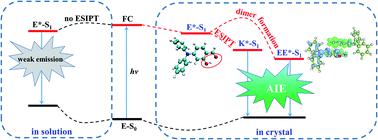Our official English website, www.x-mol.net, welcomes your
feedback! (Note: you will need to create a separate account there.)
Aggregation-induced emission spectra of triphenylamine salicylaldehyde derivatives via excited-state intramolecular proton transfer revealed by molecular spectral and dynamics simulations
RSC Advances ( IF 3.9 ) Pub Date : 2021-11-18 , DOI: 10.1039/d1ra07388e Qing Zhang, Yuanyuan Li, Zexing Cao, Chaoyuan Zhu
RSC Advances ( IF 3.9 ) Pub Date : 2021-11-18 , DOI: 10.1039/d1ra07388e Qing Zhang, Yuanyuan Li, Zexing Cao, Chaoyuan Zhu

|
Aggregation-induced emission (AIE) spectra accompanied by excited state intramolecular proton transfer (ESIPT) for two triphenylamine salicylaldehyde derivatives (namely, TS and TS-OMe) are investigated by performing molecular spectral and dynamics simulations associated with the hybrid quantum mechanics/molecular mechanics (QM/MM) at the quantum level of the time-dependent density functional theory. The simulated emission spectral peaks and Stokes' shifts are in good agreement with the experimental results for both TS and TS-OMe. Furthermore, the AIE spectral mechanisms are well explained to be associated with the ESIPT processes for both TS and TS-OMe monomers in the aggregated crystal state, while the AIE spectra mechanism for the TS-OMe (TS) dimer is accompanied by intermolecular charge-transfer excitation process. Besides, the TS dimers also contributed to the AIE mechanisms in the crystal with the intermolecular charge-transfer from one monomer to another. In addition, the TS dimers are contributed to the AIE mechanisms in the crystal with the intermolecular charge-transfer from one monomer to another. On the other hand, simulated emission spectra for both the TS and TS-OMe monomers in acetonitrile solution are involved in mixed emission with and without the ESIPT process, as interpreted by nonadiabatic molecular dynamics simulation. It is also briefly addressed that the emission spectra in the solution are weak and enhanced in the crystal. The present study provides a great physical insight into the design of highly efficient AIE compounds.
中文翻译:

分子光谱和动力学模拟揭示了三苯胺水杨醛衍生物通过激发态分子内质子转移的聚集诱导发射光谱
通过进行与混合量子力学/分子力学相关的分子光谱和动力学模拟,研究了两种三苯胺水杨醛衍生物(即 TS 和 TS-OMe)的聚集诱导发射(AIE)光谱以及激发态分子内质子转移(ESIPT) (QM/MM)在时间相关的密度泛函理论的量子水平上。模拟的发射光谱峰和斯托克斯位移与 TS 和 TS-OMe 的实验结果非常一致。此外,AIE 光谱机制被很好地解释为与聚集晶态下 TS 和 TS-OMe 单体的 ESIPT 过程相关,而 TS-OMe (TS) 二聚体的 AIE 光谱机制伴随着分子间电荷-传递激发过程。此外,TS二聚体还有助于晶体中的AIE机制,即分子间电荷从一个单体转移到另一个单体。此外,TS 二聚体有助于晶体中的 AIE 机制,将分子间电荷从一个单体转移到另一个单体。另一方面,乙腈溶液中 TS 和 TS-OMe 单体的模拟发射光谱都涉及有和没有 ESIPT 过程的混合发射,如非绝热分子动力学模拟所解释的。还简要说明了溶液中的发射光谱较弱而晶体中的发射光谱增强。本研究为高效 AIE 化合物的设计提供了深入的物理见解。
更新日期:2021-11-18
中文翻译:

分子光谱和动力学模拟揭示了三苯胺水杨醛衍生物通过激发态分子内质子转移的聚集诱导发射光谱
通过进行与混合量子力学/分子力学相关的分子光谱和动力学模拟,研究了两种三苯胺水杨醛衍生物(即 TS 和 TS-OMe)的聚集诱导发射(AIE)光谱以及激发态分子内质子转移(ESIPT) (QM/MM)在时间相关的密度泛函理论的量子水平上。模拟的发射光谱峰和斯托克斯位移与 TS 和 TS-OMe 的实验结果非常一致。此外,AIE 光谱机制被很好地解释为与聚集晶态下 TS 和 TS-OMe 单体的 ESIPT 过程相关,而 TS-OMe (TS) 二聚体的 AIE 光谱机制伴随着分子间电荷-传递激发过程。此外,TS二聚体还有助于晶体中的AIE机制,即分子间电荷从一个单体转移到另一个单体。此外,TS 二聚体有助于晶体中的 AIE 机制,将分子间电荷从一个单体转移到另一个单体。另一方面,乙腈溶液中 TS 和 TS-OMe 单体的模拟发射光谱都涉及有和没有 ESIPT 过程的混合发射,如非绝热分子动力学模拟所解释的。还简要说明了溶液中的发射光谱较弱而晶体中的发射光谱增强。本研究为高效 AIE 化合物的设计提供了深入的物理见解。











































 京公网安备 11010802027423号
京公网安备 11010802027423号